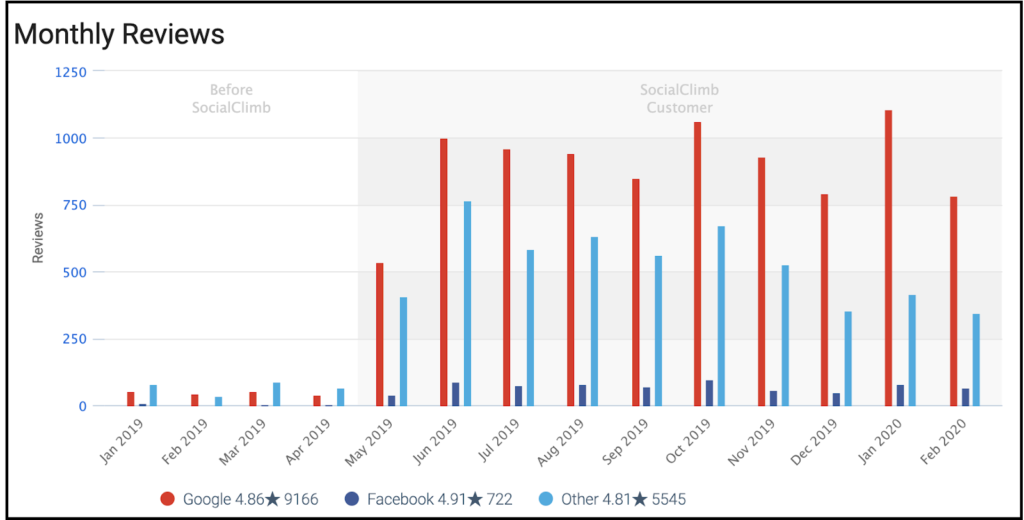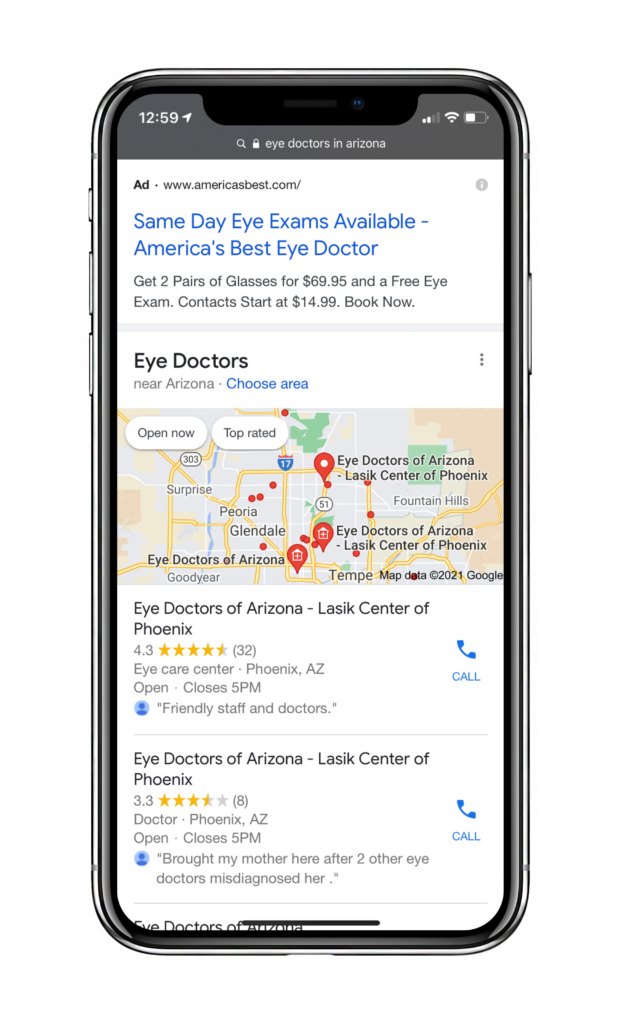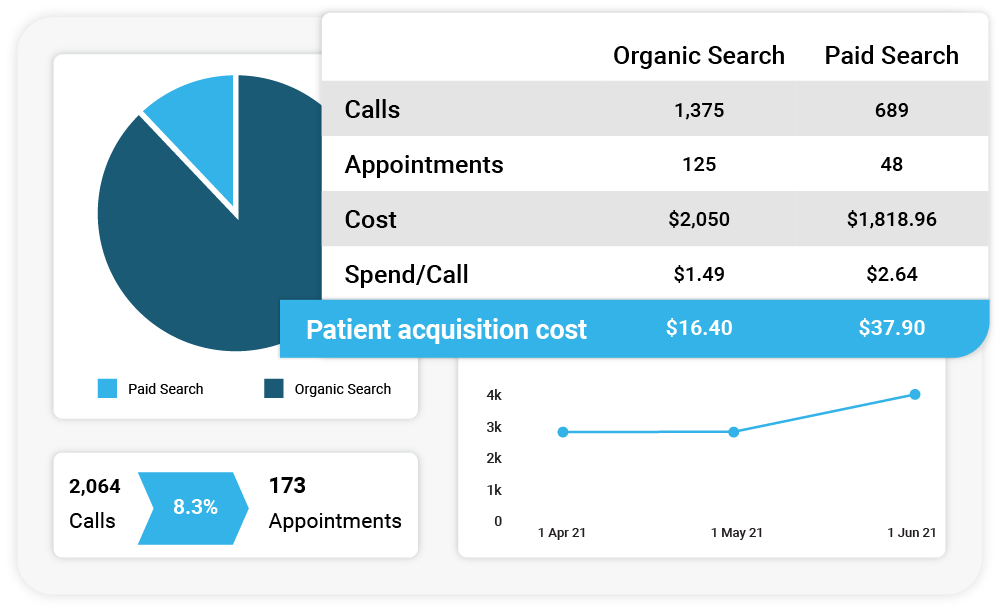To market effectively, you need to measure the success of your healthcare marketing.
You may have been told that collecting healthcare marketing data is not really possible thanks to HIPAA regulations. It’s true that keeping patient data protected and confidential is important. It’s also true that you can be HIPAA compliant AND collect the metrics you need to know those important data points that measure effectiveness—including ROI.
Measuring success in healthcare marketing gives you the information you need to make data backed decisions. And in order to measure success, you need to know where your patients are coming from and which of your marketing tactics put them on your schedule. With that knowledge, you can fine-tune your marketing spend so every dollar makes a difference.
So how can measurement be HIPAA compliant? HIPAA-compliant platforms that integrate with your PM/EHR work within the safety of those walls. With the proper protections in place, this software will analyze your data, create the reports you need, and keep you HIPAA compliant. All at the same time.
How do you measure success in healthcare marketing?
These six important results will show you the effectiveness of your marketing efforts. It’s not an exhaustive list, but it’s the right place to start if you’d like to get more patients and grow your practice.
6. Improve your star rating.
Patients read online reviews. A recent study found that 71% of patients begin their search for a new doctor by reading reviews, and 94% turn to reviews at some point in the process. Your reviews and the ratings derived from those reviews need to accurately reflect how happy your patients are with the care they receive, because patients looking for a great doctor will pass right by those low star ratings.
Unfortunately, it’s patients with strong feelings who leave unsolicited reviews—patients who are either very unhappy or very happy. The result? Your reviews can be more negative than they should be.
It’s an easy issue to fix.
The solution is to ask for reviews. When you ask patients to leave reviews, many are happy to do so. The most effective way is to use a platform that integrates with your EHR to send review requests automatically. We have found that about 10% of patients who receive a personalized text or email request to leave a review will do so.
You can also try putting up a sign in your office asking for reviews or even directly asking patients if they would be willing to leave some feedback. The important thing is to get more reviews from your silent majority of happy patients, and your star rating will naturally go up. We’ve seen it time and time again.
How to measure:
This one is easy. Check your star rating on your Google Business Profiles (GBP), Doctor.com, Healthgrades, Vitals, and other platforms, and watch your ratings improve as you get more people talking.
5. Increase your review volume.
It’s not just the quality of your reviews that needs attention, you also need to make sure you have a high number of reviews. Consumers read about 10 reviews before they will trust a business. When you only have a couple of reviews, that’s not enough to build that trust.
When it comes to Google reviews specifically, more reviews help you show up in online search results. A vast majority of people, 92% to be exact, use Google to search for information. That means you have to rely on Google’s algorithms to get seen.
Here’s how it works. A patient goes to Google to find a “doctor near me.” It could be an orthopedic doctor, a heart specialist, a dentist, a therapist—the options are endless. Google pulls up a 3-pack of GBPs, also called a map pack. You need to show up in that 3-pack. That means you need to look relevant to Google.
You can greatly improve your chances of getting in the map pack by owning and optimizing your GBP and making sure you are continually pulling in reviews. Watching your number of reviews is a great indication that your efforts in getting your patients talking is working. More reviews will improve your star rating—unless your rating is already stellar—and make you look important to Google.
So start sending those review requests!
How to measure:
Keep track of how many reviews you have now and watch the number go up. If you are using a healthcare marketing or review management platform, you should be able to pull a report and track data from the platform. Maybe something that looks like this:
 4. Get to the top of the SERP.
4. Get to the top of the SERP.
 The SERP—or search engine results page—is the first page of results that displays when you search for information online. It’s important to show up on that first page because most consumers will not move to the next page. In fact, the higher you show up on the page, the better your odds of getting clicked.
The SERP—or search engine results page—is the first page of results that displays when you search for information online. It’s important to show up on that first page because most consumers will not move to the next page. In fact, the higher you show up on the page, the better your odds of getting clicked.
We already talked about one way to show up at the top of the page—and that’s showing up in the map pack. Those GBPs are golden because they are free advertising for your individual doctors and your practice.
Here’s another tip: Sometimes Google will display a paid advertisement or two (also known as search or brand ads) above the map pack. You can set up an ad to claim that top position, and if you’re in the map pack as well, that nails down two of those top spots. You may even have both a doctor from your practice and the practice itself show up in the map pack, and boom—you’ve grabbed three of those spots.
After the map pack you’ll see organic results such as websites as well as more ads in some cases. A well-optimized website gets you even more visibility. When you show up in multiple places on the top of the SERP, you’ll dominate the market in your area.
How to measure:
A quick and dirty way to see where you stand on the SERP is to search it yourself. Type in a query in your area, and see what comes up. The problem is, you have so many keyword options to choose from, you can only get an idea of what prospective patients may see.
For more data-backed results, you should really do a SERP analysis using an SEO or SERP tool like Moz Pro SERP, SEMrush, SERP Checker, or Ahrefs Keyword Explorer. Doing so will give you a better view of where you are and what you can do to improve your situation.
3. Track your patient calls.
You may already be familiar with the need to improve your visibility and manage your reputation. And you can measure those results in fairly traditional ways without any HIPAA-related concerns. But when it comes to tracking your patient calls to see which marketing channels attracted them, you’re entering dangerous territory.
Or are you?
With that HIPAA-compliant integration we mentioned earlier, the right platform can work inside security walls to track calls from each and every marketing campaign. When your patients call from your GBP, a paid ad, your website, or any other source, you can track that—as long as you have the right systems in place—so you can know how your patients found you, DOWN TO THE PATIENT NAME.
This is the piece that has been missing for so long in healthcare marketing. It’s not appropriate for traditional marketing technology to track all that because it’s so important to keep patient information safe. But HIPAA-compliant technology that works inside your EHR makes it possible to track the data and give you the information within that security environment.
That’s right, healthcare marketing has caught up to traditional business marketing.
How to measure:
You can put a unique phone number on each marketing campaign so the platform can tell which source the call is coming from. When the call comes in, the patient’s phone number is checked against known numbers already found in your database so you know if they are a new or existing patient. The report you receive will tell you how many calls you received from each marketing tactic and which of those calls were from new patients.
2. Know your PAC.
That call tracker data is key to knowing your patient acquisition cost—the “missing link” of healthcare marketing. Knowing which campaigns are driving patients through your doors means you can calculate your patient acquisition cost (PAC) and set your budget with an excellent grasp of what the result will be.
If you need 50 more patients a month to fill your schedules, for example, you can turn up your ad spend accordingly. And if you have a new doctor starting with your practice, or if you’re opening up a new location, you’ll be able to plan financially to get them up and running and reach profitability more quickly.
Here’s how it works: Software integrated with your EHR can see where that call is coming from, assign it to the appropriate campaign (organic, paid ads, website, etc.), see how many appointments were made by new patients, and do all the math for you.
How to measure:
Your PAC is easy to measure. You simply divide the cost of your marketing campaign by the number of appointments made from that campaign. Looking at the image below, this practice spent $2,050 on managing their online reputation and taking steps to show up in organic searches, including optimizing their GBPs. From the calls coming in from their GBPs, 125 appointments were made. Dividing the cost ($2,050) by the number of appointments (125) shows a patient acquisition cost of $16.40 for organic search.
The PAC from their paid advertising campaign (tracking calls that came in from their ads) is $37.90.
1. Understand your ROI.
ROI used to be the “holy grail” of healthcare marketing. Now that the technology is in place to calculate an accurate ROI, that metric has become indispensable. If you’re not calculating your ROI at this point in the game, is there really a point in spending all those marketing dollars?
Maybe that’s an exaggeration, maybe it’s not. You decide. Here’s the information you need to make that decision for your practice.
The ability to track where new patients are coming from has changed the game in healthcare marketing. Where before, measuring the effectiveness of your marketing included quite a bit of guesswork, the technology is in place to give you the power to lead with data. That means you can try three different campaigns, drop the two that bring in a lower ROI, and focus your spend where it will do the most good.
Knowing your ROI will also help you tweak your website and ads to better reach target markets and improve your results. If you have the ability to measure your ROI, it’s crazy not to do it.
How to measure:
ROI is only a slightly more complicated equation than PAC. To do the math, you’ll need to know the revenue each patient brings in. You can make the calculation with exact numbers for each patient, or you can use an average patient revenue for your practice or even from a particular procedure.
- Let’s say your average patient revenue is $800.
- Your ad campaign brings in 48 new patients.
- Your total revenue from that campaign is found by multiplying $800 by 48 (which is $38,400).
- You spent $1,818.96 on your ad campaign. (Yes, I’m using numbers from the image above.)
Now we can get to the calculation.

(Revenue ($38,400) – Marketing Spend ($1,818.96)) divided by Marketing Spend ($1,818.96) and then multiplied by 100 is 2,011% ROI. Clearly, that ad campaign is a fantastic investment.
Our Solution
You need to be measuring your success in your healthcare marketing efforts. Some of this you can do on your own, or you can find a platform, like ours, that makes it easy. The best part is, you can use our platform to measure the effectiveness of all your marketing campaigns—whether you do them from our platform or not.
Schedule a 15-minute conversation with one of our experts to see how our solution will help you measure your marketing.















